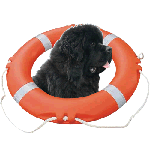(By Ainsley Hawthorn - CBC-NL, August 2 2020)
Of all the features that set Newfoundland and Labrador apart, one of the most remarkable and delightful is that we have not one but two breeds of dog to our name.
The Newfoundland dog and the Labrador retriever are two of the world's most beloved breeds, and both owe their existence to a common ancestor that developed in our province as a fisher's companion: the St. John's water dog.
Also known as the Lesser Newfoundland, the true Newfoundland, or the Small Labrador, the St. John's water dog probably evolved out of English, Irish and Portuguese working breeds that were brought to our shores by European fishermen over the course of the 16th and 17th centuries.
These transplanted pups were interbred by locals to create a distinct dog type that was as much at home in the water as on land.
Because of their versatility, St. John's dogs became mainstays of rural and outport life. With their natural retrieving instincts, they could fetch hunted birds on land as easily as fish fallen from a net at sea. They could alert their owners like a watch dog or play with children like a house pet. In Labrador, they were sometimes even used on sled teams.
It was their aptitude for aquatics, though, that most distinguished the St. John's dogs. Their oily coats repelled water, while their webbed feet and thick, oar-like tails made them nimble swimmers.
They could paddle effortlessly through the frigid waters of the Atlantic to pull fishing lines and heavily-laden nets back to their masters' boats.
They were also impressive divers. In 1847, agricultural author H.D. Richardson described a St. John's water dog he had seen in Dublin "which dived repeatedly to the bottom of the canal, between the locks, when full of water, and fetched up such stones, &c., as were thrown in."
Bred for function
Because St. John's dogs were bred for function instead of form, their appearance could vary. Generally speaking, they were stocky, medium-sized canines whose fur could be long or short, smooth or feathered, and almost any colour.
Over time, black with white patches emerged as the most common colouring, and many St. John's dogs could be recognized by their "tuxedo": a large white mark on a black chest, resembling a shirt under a tuxedo jacket.
A number of common outport tasks were too strenuous for a medium-sized dog. As a result, some St. John's dogs were bred to a larger size so they could help with hauling wood and pulling sleighs.
These heftier pups were the forebears of our modern Newfoundland dogs. Eventually, they were crossed with European mastiffs, bestowing on them the broad heads and beefy builds that are the hallmarks of the breed today.
The smaller St. John's dogs that remained followed a different evolutionary path. Their loyalty, work ethic, and natural retrieving instincts caught the eye of the British aristocracy, who recognized their value as hunting companions.
As early as 1809, the second Earl of Malmesbury had a St. John's dog that joined him on shooting expeditions, and he and his descendants became avid breeders of the dogs, importing new animals from Newfoundland to keep the bloodline going.
A Large Family Tree
Meanwhile, the Dukes of Buccleuch in Scotland had started their own St. John's dog breeding program, and, after a chance meeting between the two families in the 1880s, the Malmesburies gave two male dogs to the Buccleuchs to mate with their females. The puppies that resulted became the ancestors of the Labrador retrievers we know today.
But the St. John's dog's family tree didn't end there. In fact, every modern retriever breed descends from them.
In his 1872 book on dogs, the Rev. Thomas Pearce explained why: "The Newfoundland, the Labrador, and the St. John's dogs have this peculiarity – they not only possess sagacity, but they disseminate it through any number of crosses, or at least through a great number of them. On this account their breed has been used almost universally in improving Retrievers, and with great success."
Despite their popularity elsewhere, in Newfoundland and Labrador itself the St. John's dog gradually went into decline.
During the late 19th century, the Newfoundland government began to promote sheep farming. Since St. John's dogs – especially the larger Newfoundland type – had a taste for sheep, the colonial administration levied a heavy tax on dogs to limit their numbers.
As outport culture weakened over the course of the 20th century and communities were resettled or abandoned, these dogs ultimately disappeared along with the outport lifestyle. It's believed that the last two St. John's water dogs, both male, died of old age in Grand Bruit on the south coast in the early 1980s.
Their legacy, though, lives on in the Newfoundland dog's gentle temperament, the Labrador's love of water, and the tireless spirit of retrievers the world over."








































